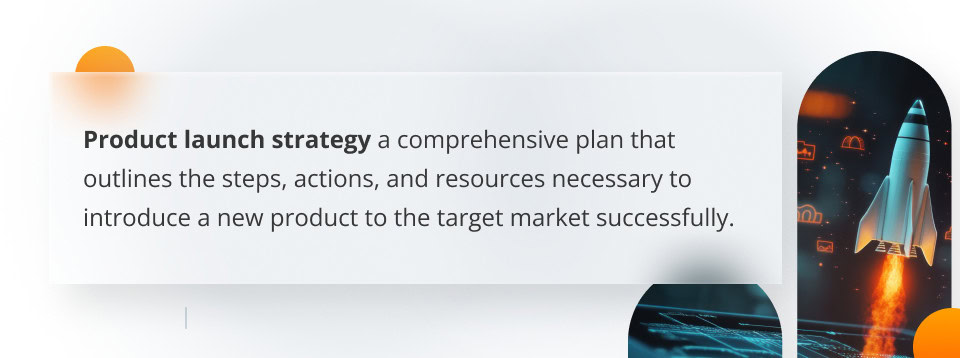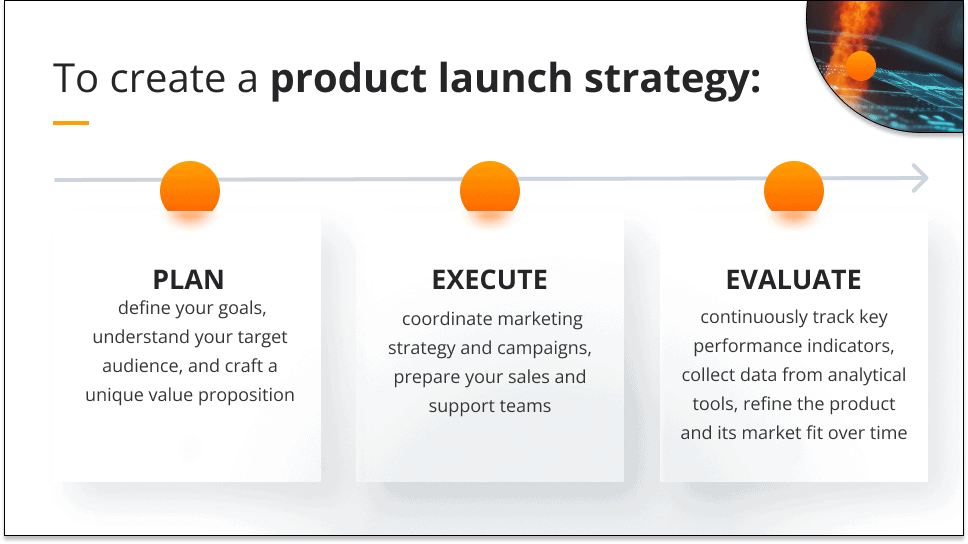
How to create a successful product launch strategy?
Read our guide on how to create a successful launch strategy for your product.
Creating a product is a long and complicated process, yet the launching it is equally important. A successful product launch can make or break the success of your product in the market.
This is why today we focus on exploring key elements needed for a successful product launch strategy, which doesn’t start from a blank slate but builds on the product’s development process, research, and insights gathered along the way.
What are the key steps in creating a successful product launch strategy?
Before we get into details, let’s look at what product launch strategies are.
A product launch strategy is a comprehensive plan that outlines the steps, actions, and resources necessary to introduce a new product to the target market successfully.
It involves careful coordination across various departments – marketing team, sales team, product managers, and customer support – to ensure a seamless and impactful launch. Among these, product managers or owners play a pivotal role, as they are deeply involved from the very beginning in shaping the product’s initial vision and assumptions. Their leadership and accountability are critical to driving the launch strategy and ensuring the product’s success in the market.

A product launch strategy includes defining your target audience, crafting a compelling value proposition, and setting clear goals. It also covers the timing of the launch, the marketing channels through which you’ll promote the product, and the messaging that will resonate with your target audience.
It’s important to note that defining the audience and value proposition should firstly be addressed at the product strategy level. At this stage, the focus shifts to how these elements are presented to a broader audience or a group that is crucial for driving sales in the initial phase.
To create a product launch strategy you need to think of three fundamental stages: planning, execution, and evaluation.
It all starts with thorough planning – this is where you define your goals, understand your target audience, and craft a unique value proposition. It’s worth remembering though that these elements should already be identified during the product strategy phase. At this stage, the focus is on validating those assumptions or conducting qualitative and quantitative studies with broader audience segments to refine the marketing communication. This should always serve as an addition to the knowledge the product team has already established.
Next comes execution, where the strategy comes to life. This involves coordinating marketing strategy and campaigns, creating buzz, and preparing your sales and support teams. The right mix of promotional activities, messaging, and marketing channels will be crucial.
Finally, evaluation is key to measuring the success of your launch. This process should be iterative, leveraging methodologies like Continuous Product Discovery and fostering a mindset of ongoing improvement.
By tracking key performance indicators (KPIs) such as sales numbers, customer feedback, and market response, as well as collecting data from analytical tools integrated with the product and conducting in-depth interviews based on emerging insights, you can refine the product and its market fit over time. This iterative approach ensures your product evolves to meet customer needs effectively.

How do I identify my target audience for a product launch?
Identifying your target audience is a crucial step in ensuring your launch plan hits the mark. Start by analysing demographics – basic characteristics such as age, gender, income, education, and geographic location. These factors provide a broad understanding of your potential customers.
Next, explore psychographics, which delve into your audience’s values, lifestyle, interests, and attitudes. This helps you connect with your audience on a deeper, emotional level. To make these valuable insights actionable, develop detailed buyer personas – fictional, data-driven profiles representing your ideal customers. These personas outline their goals, challenges, behaviours, and purchasing patterns.
It’s also essential to keep in mind the dynamics of introducing new products to the market. At the initial stage, focus on identifying individuals most receptive to new offerings – innovators and early adopters – before targeting a more conservative, mainstream market. This perspective should guide the identification of both the demographic and psychographic traits of your personas.
Read more about creating a great product:
- Product roadmap guide: design the path to success
- The Product Culture – everything you must know
- Product success: how to create a great product?
- Functional design 101: creating products that people love to use
What role does market research play in a product launch strategy?
When shaping an effective product launch strategy, market research is essential. It provides insights that help you make informed decisions and reduce risks. It also allows you to understand market landscape, customer needs, and potential demand, ensuring your product is positioned effectively.
A key element of market research is competitor analysis. By studying competitors’ products, pricing, marketing tactics, and customer feedback, you can identify gaps in the market and opportunities for differentiation.
One of the key outcomes of competitor analysis is crafting an attractive offer, including pricing, as even a great product won’t sell without a realistic and market-appropriate pricing strategy. This is especially crucial for products that are not highly innovative or lack a groundbreaking value proposition.
Customer insights are also invaluable. They reveal your target audience’s pain points, values, and motivations. This data guides everything from product features to messaging, ensuring your launch resonates with customers.
What is the importance of a clear value proposition in a product launch?
A clear value proposition is the foundation of all successful product launches. It communicates why your product is the solution your target audience needs.
A value proposition defines the unique benefits your product offers and sets it apart from competitors.
It’s worth keeping in mind that the product launch strategy is a derivative of the product strategy.
Crafting a strong value proposition involves identifying your product’s key differentiators – whether it’s a unique feature, an affordable price, or an innovative solution to a common problem. Once these differentiators are clear, translate them into a compelling message that speaks directly to your audience’s pain points and desires.
Remember that this message should be concise, memorable, and focused on how your product improves the customer’s life or business. By clearly articulating the value your product provides, you capture attention, build trust, and increase the likelihood of a successful product launch, all while anchoring these values around your brand and building your brand identity.
How do I align my product launch with my brand identity?
Aligning your product launch with your brand identity is vital to creating a cohesive and authentic customer experience. Your product launch should reflect your brand’s values, tone, and personality across all elements, from messaging to visuals to customer interactions.
Here are the steps to follow:
- Begin by ensuring the product itself embodies your brand’s core values – whether it’s innovation, sustainability, or quality – so it feels like a natural extension of your brand.
- Tailor your messaging and digital marketing to match your brand’s tone. If your brand is playful and fun, your launch should use lighthearted language; if your brand is more serious and professional, your approach should be sophisticated and informative.
- Remember that consistency across all touchpoints – website, social media, advertising, and packaging – reinforces your brand identity, builds trust, and fosters customer loyalty. A well-aligned product launch not only introduces a new product but strengthens your overall brand.
How do I create a compelling product launch plan?
Making product launch successful involves structuring your strategy into three phases: pre-launch, launch day, and post-launch.
The pre-launch phase is about building anticipation. Focus on market research, identifying influencers, creating teaser campaigns, and preparing your sales and customer support teams. Offer exclusive sneak peeks, early access, or limited-time offers to create urgency.
Early access – providing a select group of customers with the opportunity to use the product before it’s officially released – particularly in B2B products, serves as a bridge between the completion of product development (when it is fully functional) and the official launch.
Even if aimed at a select, trusted group of customers, early access can provide them with an opportunity to use the product before it’s publicly available, often as part of a favourable financial arrangement
On launch day, ensure all elements come together seamlessly. Roll out your full marketing campaign, activate social media buzz, and ensure your website and systems can handle traffic and sales. Make the launch feel like an event – use countdowns, live streams, or product demos to engage your audience.
The post-launch phase is about maintaining momentum and evaluating success. Continue engaging with customers through follow-up emails, surveys, and social media. Analyse sales data and customer feedback to assess the effectiveness of the launch and make necessary adjustments. Structuring your launch into these phases helps create excitement, drive sales, and sets the stage for sustained growth.
What are the most common pitfalls to avoid during a product launch?
During a product launch, several common pitfalls can hinder success and avoiding them is key to ensuring a smooth and effective launch.
One major pitfall is lack of preparation – failing to thoroughly test your product, refine messaging, or prepare your sales and support teams can lead to a chaotic launch and dissatisfied potential customers. Another mistake is underestimating demand. If you don’t plan for inventory or website capacity, you risk stockouts or system crashes, which can damage your brand’s reputation.
Additionally, ignoring feedback can be detrimental. It’s essential to listen to early adopters, address concerns, and make adjustments if needed, rather than brushing off criticism. Inconsistent messaging across channels is another red flag – ensure that your branding, tone, and key messages are uniform across all platforms to avoid confusing your audience.
Lastly, neglecting post-launch activities can stifle long-term success. Engaging with customers, tracking performance, and optimising your strategy post-launch are crucial for sustaining growth.
One of the most significant pitfalls, however, is overpromising or under-communicating. Overpromising creates unrealistic expectations that can damage your brand’s credibility if the product fails to meet them. It’s vital to be transparent and honest about what your product can deliver.
On the other hand, under-communicating can leave your audience uninformed or disengaged, potentially causing confusion or frustration. Clear, consistent communication about your product’s features, benefits, and launch details in all your marketing campaigns is essential to avoid missed opportunities.
If you want to create a product launch strategy and avoid common pitfalls, reach out to Future Processing. Our team of experts can help you strategise, plan, and execute a successful launch that aligns with your goals and delivers results. Contact us today to get started!




